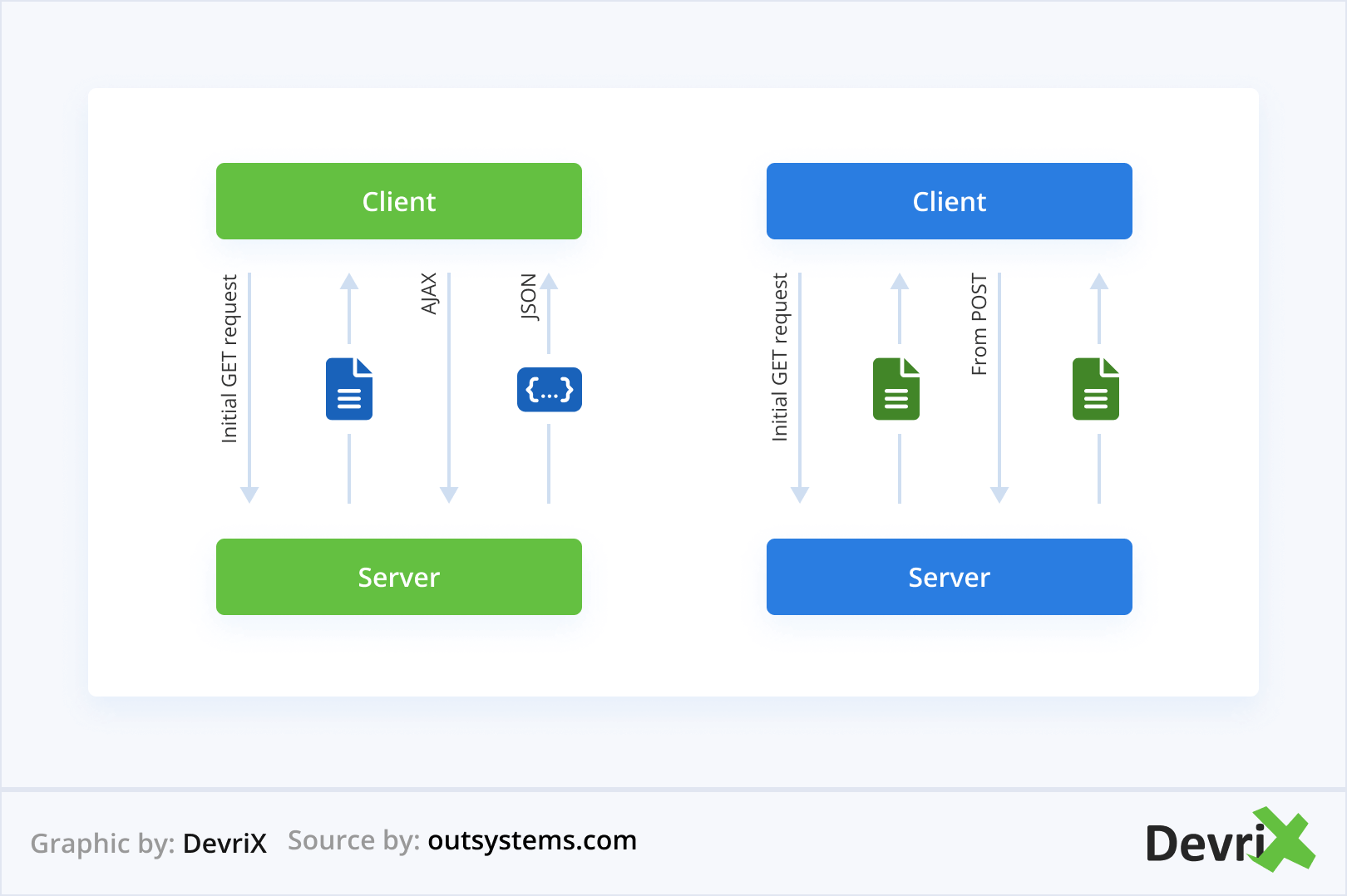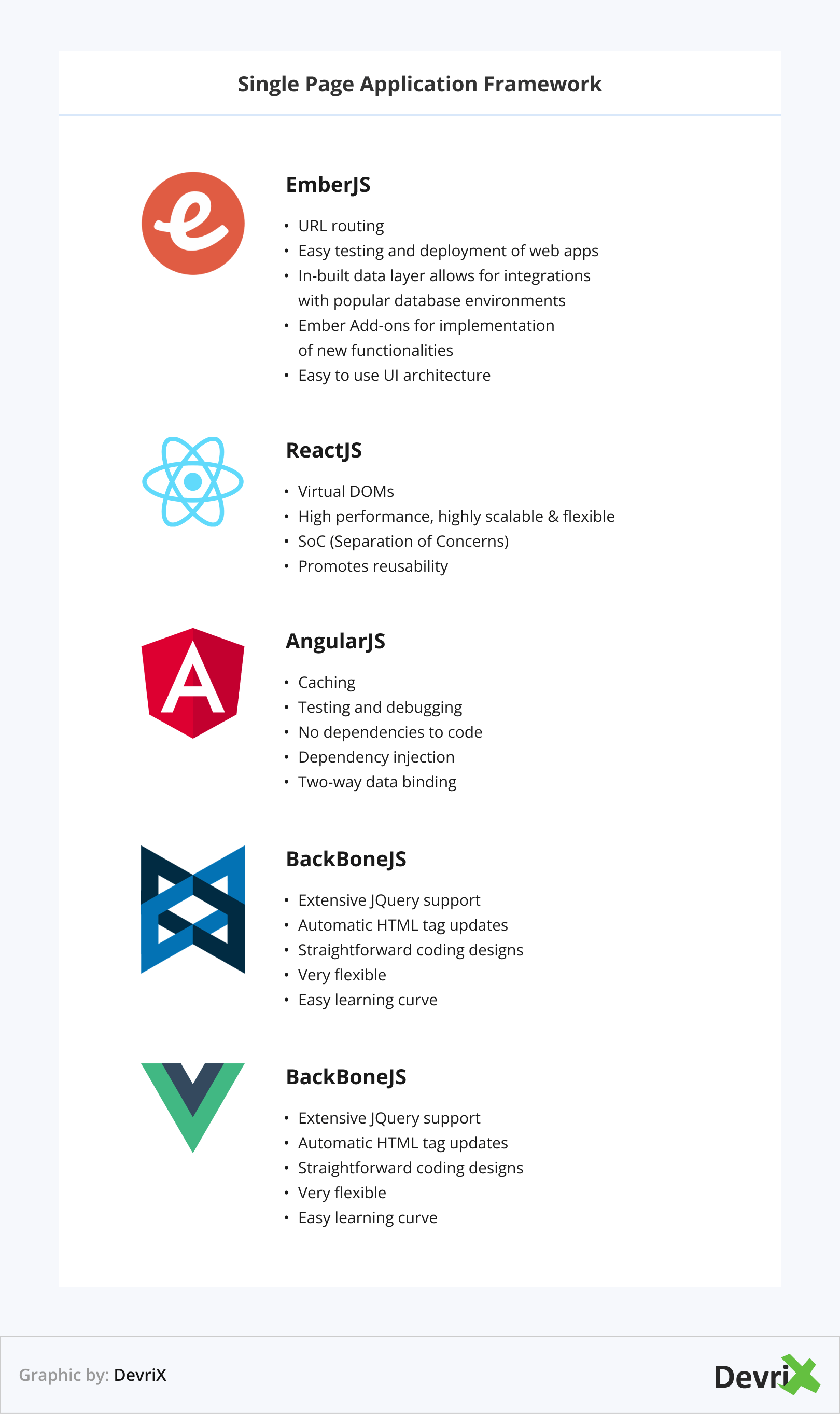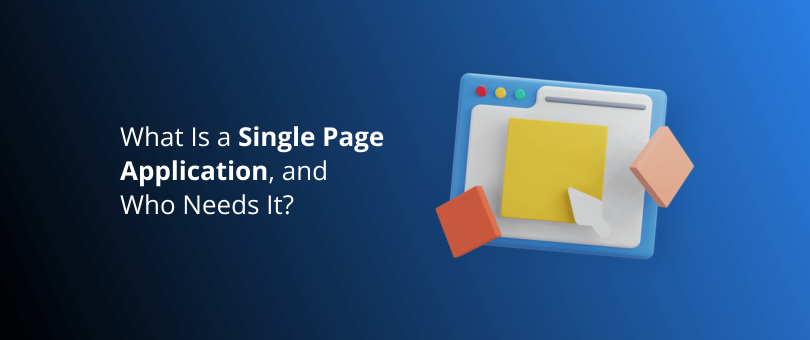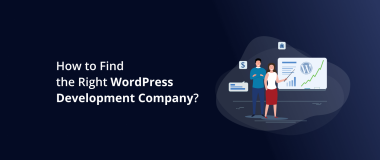You probably visit websites like Netflix, Pinterest and Gmail on a daily basis.
Did you know that these are all single page applications?
That’s correct.
Perhaps you’re hearing this term for the first time, and you’re wondering what it means?
Patience.
In this article, we’re going to provide more information on what a single page application is, the pros and cons, when you should use it, and if it is better than multi-page applications.
Ready?
Go.
What Is a Single Page Application?

A single page application is an app or website that works within a browser and does not reload the page while you’re using it.
Everything loads on a single page, as the name suggests, instead of having multiple pages like the websites we’re all familiar with.
Think of Facebook – every feature and aspect of the app is displayed on a single page, hence the popularity of endless scrolling.
Now imagine what it would look like if it was a multi-page application – different menus and categories, leading to different pages.
It kind of loses its charm now, doesn’t it?
Nevertheless, there are situations where an SPA isn’t the best option to use and vice versa.
Let’s explore when a single page app is appropriate and when not to rely on it.
SPA Pros
Single page applications have a lot of advantages, which we’ll present briefly.
- Speed is considered the main advantage of using a single page application. Like most of the resources, a single page app requires things like HTML, CSS and various scripts, which are already loaded when you launch the application. This means the app doesn’t need to reload while you’re using it. The sole component that changes is the data transmitted from and to the server. The end result is that the app is very responsive and saves time from client-server communication.
- Development is simpler and smoother, as there’s no need to write code to render the pages on a server. It’s even better if you have a team of developers, as backend developers can focus on the API, while frontend developers carry out the UI.
- Mobile apps become easier to make, since the developer can reuse the backend code. Instead of using time to write code for both mobile and desktop applications, the developer uses the same server-side code and API.
- Debugging is easier, as well. The Chrome browser has special tools for main technologies SPAs use, (React & Angular Batarang) which makes the process faster and easier. You can also monitor network applications, and investigate page elements.
- Caching is efficient, since the app only sends one request, stores all transmitted data, and can then use this data.
Nothing in life is perfect, so let’s take a look at the bad side of using single page applications.
SPA Cons
- SEO is challenging, because the content is loaded through AJAX (Asynchronous JavaScript and XML). This is a method of updating the application without refreshing the page.
- JavaScript is mandatory to run single page applications. If you disable JavaScript on your browser, SPAs will not present at all.
- Security risks are higher compared to “traditional” apps. This is because SPAs use XSS (Cross-site scripting) which enables attackers to inject malicious client-side scripts into applications.
- Memory leaks can happen. The app can run for hours at a time, which can deplete the available memory on the user’s machine.
Related article:
Getting Started with Headless WordPress [Example Included]
Single Page Application Framework
After we’ve outlined the pros and cons of using single page applications, let’s discuss the popular frameworks used to develop SPA.
 EmberJS
EmberJS
All EmberJS applications work as single page applications. This framework offers basic templates, however it also features some high-end functionalities such as:
- URL routing
- Easy testing and deployment of web apps
- In-built data layer allows for integrations with popular database environments
- Ember Add-ons for implementation of new functionalities
- Easy to use UI architecture
ReactJS
Even though it has a wide range of features, ReactJS is actually a JavaScript library of UI components, created and maintained by Meta (formerly Facebook). The component based structure shapes ReactJS to be a lightweight solution for building single page apps. React is considered to be among the best frameworks for SPA development, due to its features, which include:
- Virtual DOMs
- High performance, highly scalable & flexible
- SoC (Separation of Concerns)
- Promotes reusability
AngularJS
Angular is developed by Google and is one of the oldest open source JavaScript frameworks. It has multiple purposes and is one of the most preferred frameworks by front-end developers. Here are some of its main features:
- Caching
- Testing and debugging
- No dependencies to code
- Dependency injection
- Two-way data binding
BackBoneJS
BackBone is another very lightweight JavaScript library. Its preferred use is for development of client-based web applications. BackBone offers lots of flexibility and is very easy to use. Other features include:
- Extensive JQuery support
- Automatic HTML tag updates
- Straightforward coding designs
- Very flexible
- Easy learning curve
VueJS
Vue is a progressive, open-source JavaScript framework, mainly used for developing high-performing web apps and interfaces. Vue is a favorite pick for game development, and it’s also a good choice for single page applications, due to some of its main features:
- Minimalistic ecosystem
- Easy to use
- Two-way data binding
- Reusable components
- Easy integration with third-party applications
Popular Single Page Application Examples
Perhaps the most important aspect, from a non-technical point of view, is to imagine what single page applications can execute in practice.
At this point of the article, you might be feeling like:
That’s why we’re going to take a look at some popular single page apps and help you get a better understanding of SPA.
- Facebook. The social media giant is a great example of a single page application. Scrolling through the news feed, every piece of content is preloaded onto the page, so you don’t need to leave the page.
- Gmail. Whether you compose a message, browse through folders, or click on a message in your inbox, Gmail always remains on the same web page.
- Netflix. The streaming service uses the React framework to enable smooth access to users. Watching movies on your TV set, without much lag, is made easy thanks to SPA, especially considering how many users the site has, and how much data is being processed.
- Trello. The popular project management tool utilizes the single page application method to a large extent. Highly-interactive interface with just a single view, which makes it easier to organize your tasks without having to switch between pages.
What Is a Multi Page Application?
Multi page applications are the opposite of single page applications. The main difference is that the former consists of multiple pages. MPA’s are a classic approach to web development. These pages refresh every time data changes. Examples of MPA are forums, blogs, news websites.
MPA Pros
- SEO is easier, since every page can be individually optimized, proper SEO management can be achieved. This way you can optimize for one keyword per page, basically the regular way SEO is done.
- Better navigation is present, as multi page applications use the classic website approach with menus and categories. Most people are very familiar with this type of navigation, and so it’s much easier to find your way around a website.
- Ready made solutions. It’s really difficult to create a single page app, unless you’re familiar with JavaScript and development. Otherwise, regular users can benefit from a content management system like WordPress, which makes the process of building a website much easier, so much so that even a non-technical person can venture into website creation.
MPA Cons
- Performance issues are possible, as numerous requests mean a large number of pages need to reload. High website traffic and multiple functions on the website are other factors that will inevitably lead to problems with website performance and speed. Even though MPAs have a faster initial load time, single page apps are much faster in terms of user actions.
- Front-end and back-end integration is tedious, due to the fact that these components are deeply integrated, hence it can take longer to test and develop multi page applications.
- Security, maintenance and updates are more intimidating tasks for tech support to handle, because of the number of pages. Figuring out which page is causing issues takes longer than having a single page to troubleshoot.
Single Page Application vs. Multi Page Application: When to choose SPA over MPA
Now.
The question you’re bound to ask at this point: how do I decide whether I should use a single page application or multi page application to build my website?
To begin with, of course, it depends on the type of application/website you want to build. You need to assess your business needs and the technical resources you have available.
Consider the following questions:
Is SEO important for my website? Does my site have a large number of products and/or services? Do I want to build a dynamic platform? Do I need to manage large amounts of data? Is your web space limited?
Naturally, there’s a lot of thought processes that need to happen, as most of these questions can not be answered with a simple “yes” or “no”.
What’s important to consider when deciding to use a single page app is whether your developers can handle working with JavaScript.
Another important “to-do” is to discuss matters with your marketing team beforehand, as building a single page website could make things difficult for them.
All in all, create a detailed plan and synchronize it with your team, and only then decide if you should use a SPA or MPA.
Summary
Now you know what a single page application is, and who needs it. Moreover, you have been acquainted with SPA frameworks, and the key differences between single and multi page apps.
In fact, you can use the knowledge you gained from this article to your advantage. I bet a lot of people wouldn’t expect you to know much about JavaScript, single page applications, multi page applications, and what benefits they have in store.
Go ahead and tell them that Netflix is a single page application and how this helps them improve user experience.
But more importantly, use the information you’ve gathered and apply it to your business. That’s what truly counts.





